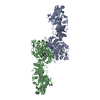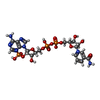+ Open data
Open data
- Basic information
Basic information
| Entry | Database: PDB / ID: 9ctk | ||||||
|---|---|---|---|---|---|---|---|
| Title | Modifying region of EcPKS2 - malonylCoA inhibited dataset | ||||||
 Components Components | Polyketide synthase 2 | ||||||
 Keywords Keywords | BIOSYNTHETIC PROTEIN / polyketide adenosyl transferase / beta-keto-synthase / dehydratase / keto-reductase / Acyl carrier protein | ||||||
| Function / homology | NADP NICOTINAMIDE-ADENINE-DINUCLEOTIDE PHOSPHATE Function and homology information Function and homology information | ||||||
| Biological species |  Elysia chlorotica (eastern emerald elysia) Elysia chlorotica (eastern emerald elysia) | ||||||
| Method | ELECTRON MICROSCOPY / single particle reconstruction / cryo EM / Resolution: 2.92 Å | ||||||
 Authors Authors | Schubert, H.L. / Hill, C.P. | ||||||
| Funding support |  United States, 1items United States, 1items
| ||||||
 Citation Citation |  Journal: Proc Natl Acad Sci U S A / Year: 2025 Journal: Proc Natl Acad Sci U S A / Year: 2025Title: The structure of full-length AFPK supports the ACP linker in a role that regulates iterative polyketide and fatty acid assembly. Authors: Heidi L Schubert / Feng Li / Christopher P Hill / Eric W Schmidt /  Abstract: The polyketide synthases (PKSs) in microbes and the cytoplasmic fatty acid synthases in humans (FASs) are related enzymes that have been well studied. As a result, there is a paradigm explaining in ...The polyketide synthases (PKSs) in microbes and the cytoplasmic fatty acid synthases in humans (FASs) are related enzymes that have been well studied. As a result, there is a paradigm explaining in general terms how FASs repeatedly use a set of enzymatic domains to produce simple fats, while PKSs use the domains in a much more complex manner to produce pharmaceuticals and other elaborate molecules. However, most animals also have PKSs that do not conform to the rules described in microbes, including a large family of enzymes that bridge fatty acid and polyketide metabolism, the animal FAS-like PKSs (AFPKs). Here, we present the cryoelectron microscopy structures of two AFPKs from sea slugs. While the AFPK resemble mammalian FASs, their chemical products mimic those of PKSs in complexity. How then does the architecture of AFPKs facilitate this structural complexity? Unexpectedly, chemical complexity is controlled not solely by the enzymatic domains but is aided by the dynamics of the acyl carrier protein (ACP), a shuttle that moves intermediates between these domains. We observed interactions between enzyme domains and the linker-ACP domain, which, when manipulated, altered the kinetic properties of the enzyme to change the resulting chemical products. This unveils elaborate mechanisms and enzyme motions underlying lipid and polyketide biochemistry across the domains of life. | ||||||
| History |
|
- Structure visualization
Structure visualization
| Structure viewer | Molecule:  Molmil Molmil Jmol/JSmol Jmol/JSmol |
|---|
- Downloads & links
Downloads & links
- Download
Download
| PDBx/mmCIF format |  9ctk.cif.gz 9ctk.cif.gz | 996.4 KB | Display |  PDBx/mmCIF format PDBx/mmCIF format |
|---|---|---|---|---|
| PDB format |  pdb9ctk.ent.gz pdb9ctk.ent.gz | 817.5 KB | Display |  PDB format PDB format |
| PDBx/mmJSON format |  9ctk.json.gz 9ctk.json.gz | Tree view |  PDBx/mmJSON format PDBx/mmJSON format | |
| Others |  Other downloads Other downloads |
-Validation report
| Summary document |  9ctk_validation.pdf.gz 9ctk_validation.pdf.gz | 1.4 MB | Display |  wwPDB validaton report wwPDB validaton report |
|---|---|---|---|---|
| Full document |  9ctk_full_validation.pdf.gz 9ctk_full_validation.pdf.gz | 1.4 MB | Display | |
| Data in XML |  9ctk_validation.xml.gz 9ctk_validation.xml.gz | 80 KB | Display | |
| Data in CIF |  9ctk_validation.cif.gz 9ctk_validation.cif.gz | 122.1 KB | Display | |
| Arichive directory |  https://data.pdbj.org/pub/pdb/validation_reports/ct/9ctk https://data.pdbj.org/pub/pdb/validation_reports/ct/9ctk ftp://data.pdbj.org/pub/pdb/validation_reports/ct/9ctk ftp://data.pdbj.org/pub/pdb/validation_reports/ct/9ctk | HTTPS FTP |
-Related structure data
| Related structure data |  45909MC  9cq1C  9cq9C  9ctiC  9ctlC  9ctmC  9ctnC  9ctoC C: citing same article ( M: map data used to model this data |
|---|---|
| Similar structure data | Similarity search - Function & homology  F&H Search F&H Search |
- Links
Links
- Assembly
Assembly
| Deposited unit | 
|
|---|---|
| 1 |
|
- Components
Components
| #1: Protein | Mass: 252993.625 Da / Num. of mol.: 2 Source method: isolated from a genetically manipulated source Source: (gene. exp.)  Elysia chlorotica (eastern emerald elysia) Elysia chlorotica (eastern emerald elysia)Production host:  #2: Chemical | #3: Water | ChemComp-HOH / | Has ligand of interest | Y | Has protein modification | N | |
|---|
-Experimental details
-Experiment
| Experiment | Method: ELECTRON MICROSCOPY |
|---|---|
| EM experiment | Aggregation state: PARTICLE / 3D reconstruction method: single particle reconstruction |
- Sample preparation
Sample preparation
| Component | Name: N-terminal condensing region of homodimer of EcPKS2 / Type: COMPLEX / Details: residues 1-877 were within the mask region / Entity ID: #1 / Source: RECOMBINANT | ||||||||||||||||||||
|---|---|---|---|---|---|---|---|---|---|---|---|---|---|---|---|---|---|---|---|---|---|
| Molecular weight | Value: 0.350 MDa / Experimental value: NO | ||||||||||||||||||||
| Source (natural) | Organism:  Elysia chlorotica (eastern emerald elysia) Elysia chlorotica (eastern emerald elysia) | ||||||||||||||||||||
| Source (recombinant) | Organism:  | ||||||||||||||||||||
| Buffer solution | pH: 7.5 / Details: pH measured at 4 degrees C | ||||||||||||||||||||
| Buffer component |
| ||||||||||||||||||||
| Specimen | Conc.: 6.5 mg/ml / Embedding applied: NO / Shadowing applied: NO / Staining applied: NO / Vitrification applied: YES | ||||||||||||||||||||
| Specimen support | Grid material: GOLD / Grid mesh size: 300 divisions/in. / Grid type: Quantifoil R1.2/1.3 | ||||||||||||||||||||
| Vitrification | Instrument: LEICA EM GP / Cryogen name: ETHANE / Humidity: 80 % / Chamber temperature: 278 K / Details: single application, single blot |
- Electron microscopy imaging
Electron microscopy imaging
| Experimental equipment |  Model: Titan Krios / Image courtesy: FEI Company |
|---|---|
| Microscopy | Model: TFS KRIOS |
| Electron gun | Electron source:  FIELD EMISSION GUN / Accelerating voltage: 300 kV / Illumination mode: FLOOD BEAM FIELD EMISSION GUN / Accelerating voltage: 300 kV / Illumination mode: FLOOD BEAM |
| Electron lens | Mode: BRIGHT FIELD / Nominal defocus max: 2200 nm / Nominal defocus min: 800 nm / Cs: 2.8 mm / C2 aperture diameter: 50 µm / Alignment procedure: BASIC |
| Specimen holder | Cryogen: NITROGEN / Specimen holder model: FEI TITAN KRIOS AUTOGRID HOLDER |
| Image recording | Electron dose: 40 e/Å2 / Detector mode: COUNTING / Film or detector model: GATAN K3 (6k x 4k) |
- Processing
Processing
| EM software |
| ||||||||||||||||||||||||||||||
|---|---|---|---|---|---|---|---|---|---|---|---|---|---|---|---|---|---|---|---|---|---|---|---|---|---|---|---|---|---|---|---|
| CTF correction | Type: PHASE FLIPPING AND AMPLITUDE CORRECTION | ||||||||||||||||||||||||||||||
| Particle selection | Num. of particles selected: 614919 | ||||||||||||||||||||||||||||||
| Symmetry | Point symmetry: C2 (2 fold cyclic) | ||||||||||||||||||||||||||||||
| 3D reconstruction | Resolution: 2.92 Å / Resolution method: FSC 0.143 CUT-OFF / Num. of particles: 258974 / Algorithm: BACK PROJECTION / Symmetry type: POINT | ||||||||||||||||||||||||||||||
| Atomic model building | Protocol: RIGID BODY FIT / Space: REAL | ||||||||||||||||||||||||||||||
| Atomic model building | Source name: AlphaFold / Type: in silico model | ||||||||||||||||||||||||||||||
| Refinement | Highest resolution: 2.92 Å Stereochemistry target values: REAL-SPACE (WEIGHTED MAP SUM AT ATOM CENTERS) | ||||||||||||||||||||||||||||||
| Refine LS restraints |
|
 Movie
Movie Controller
Controller












 PDBj
PDBj


